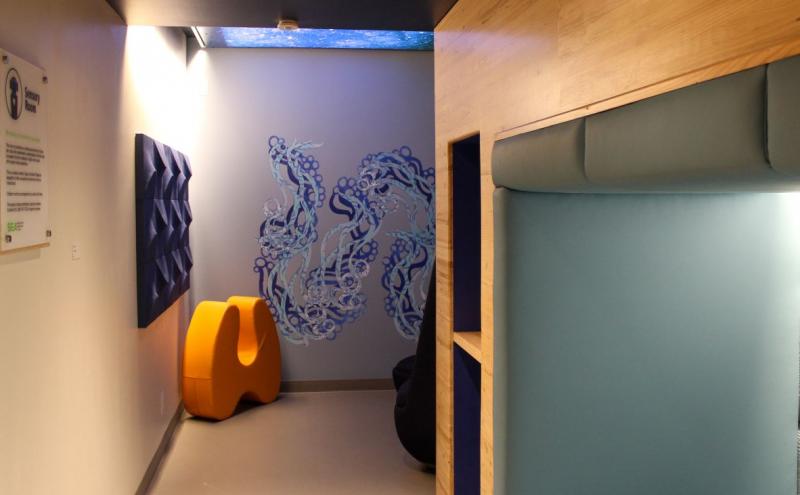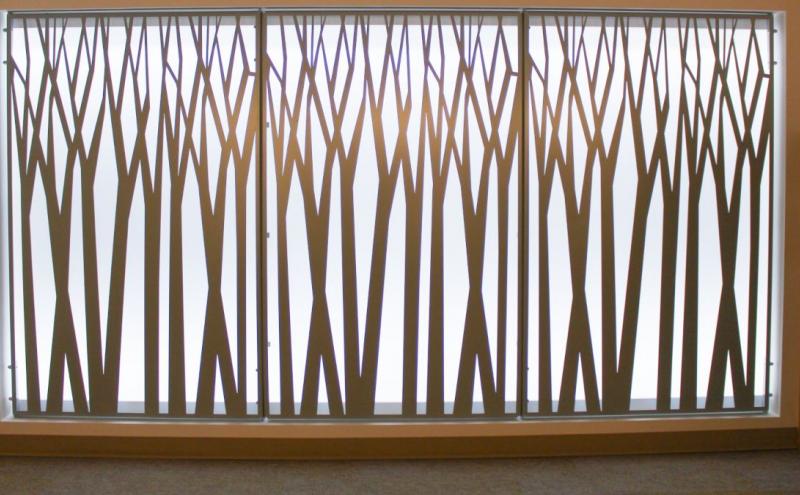
By Steve Wilhelm and Aneelah Afzali
In a beautiful example of interfaith collaboration, leaders of multiple religious denominations worked with Port of Seattle officials to develop the Interfaith Prayer and Meditation Room at Seattle-Tacoma International Airport (SEA). The room will benefit people of multiple faith and wisdom traditions.
Discussions about this space for travelers spanned more than a year and resulted in a design intended to meet the needs of airport users of multiple faiths. Together we worked hard to develop an inclusive place that will support the meditation practices and prayers of most spiritual traditions.
The groups participating in the conversations and providing support included the Jewish Federation of Greater Seattle, the Muslim Association of Puget Sound, Northwest Dharma Association (Buddhist), the Church Council of Greater Seattle, and representatives of several individual Christian churches.
Interfaith features
For starters the L-shaped space contains no religious iconography, because the team realized that specific symbols could make users feel unwelcome. Instead the key elements of the decor are semi-abstract representation of natural themes such as the flora, fauna, and waterways of the Pacific Northwest.
Seattle-based artist Weston Lambert adds to the space with a mural of emerald-colored glass called Currents. Modeled on the shape of brain waves that occur during meditation and prayer, the wave-like forms and cool tones also reference the Pacific Northwest’s abundance of water. Like the contemplative state one feels when watching light move across the waves of Puget Sound, this kinetic mural of light enables a moment of pause and repose amidst the hectic din of travel.
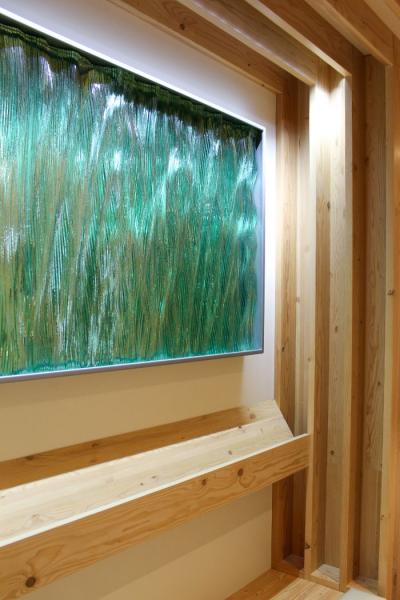
Extensive multi-faith discussions resulted in specific elements that support a wide range of traditions. For example there’s a space for Christian people (or people of any faith) to kneel and pray while facing Lambert’s artwork. The floor of the room has padded carpet and a flexible seating plan to meet the needs of Muslim users, who pray five times a day and need a space for praying and prostrating on the floor. A Qibla pointer indicates the direction of Mecca, and low movable screens provide privacy and support modesty.
“For myself and other Muslims who have struggled to find locations to pray at airports, having a designated space that facilitates prayer is significant, from a religious accommodation perspective as well as safety, privacy, and modesty,” said Aneelah Afzali, executive director of the American Muslim Empowerment Network at the Muslim Association of Puget Sound (MAPS-AMEN). "Having a space that is shared with other faith traditions is a beautiful statement of interfaith solidarity that reminds us that even though we may pray or meditate differently, we are all one connected human family, and we have the collective humility to recognize a divine power greater than us."
For meditators from Buddhist and Hindu traditions, or anyone who values silent contemplation, the room features three alcoves, each large enough for a person to sit cross-legged, separated from the adjacent person. Out of respect for the need for quiet for those praying or meditating, the room is free of music or airport announcements. Signs make it clear the space is for religious and contemplative practice, not for sleeping, studying, or socializing.
History of collaboration
This Interfaith Prayer and Meditation Room replaces a space in the center of the airport terminal, on the mezzanine level, which opened in 1971.
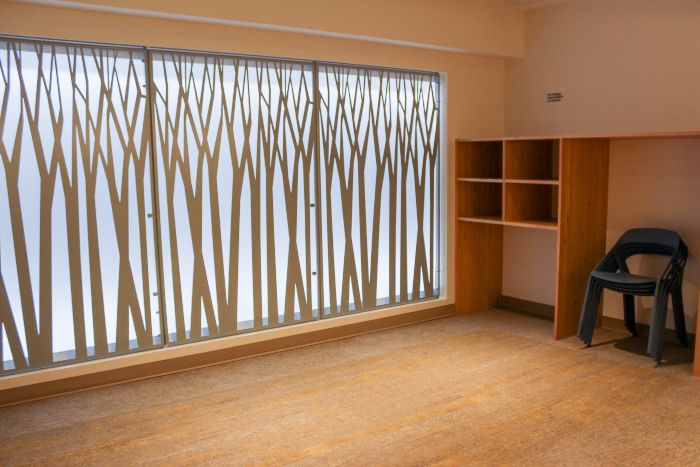
While the original prayer and meditation room was used continuously for many years, it was not used after the development of airport security because the room was outside security boundaries. This made access challenging for travelers who were arriving for flights or transferring between flights. Airport directors closed the room in 2015 because it was only lightly used and because the airport was tight on space; the room was reopened in late 2017 with encouragement from religious leaders.
The alliance between Buddhist and Muslim leaders sprang up, notably, at a screening of the movie "The Sultan and the Saint," about the collaboration between the Catholic St. Francis and the Muslim sultan of Egypt in 1218 to stop the Fifth Crusade. During and after that screening, Northwest Dharma News Editor Steve Wilhelm had several conversations with local Muslim leaders about the need for a prayer room at SEA Airport. These conversations sparked the replacement of the prayer and meditation room.
"Already I knew that the 2015 closing of the prayer and meditation room was a difficulty for travelers like myself who meditate," said Wilhelm, who practices and teaches Buddhism. "As I came to realize the difficulties the closure also posed for Muslims needing to pray, and especially for Muslim women, a natural alliance arose."
As Port officials realized the importance of a prayer and meditation room to travelers and others with spiritual and religious leanings, the collaboration between the Port and religious leaders was consistently good-natured and full of deep listening and learning. The plans came together beautifully and smoothly with a shared commitment to building a space that would benefit all.
How to get there
The Interfaith Prayer and Meditation Room is located post-security below Concourse A on the way to the STS train platform. It provides a peaceful place for meditation, worship, general reflection, and quiet time for the traveling public and the airport community.
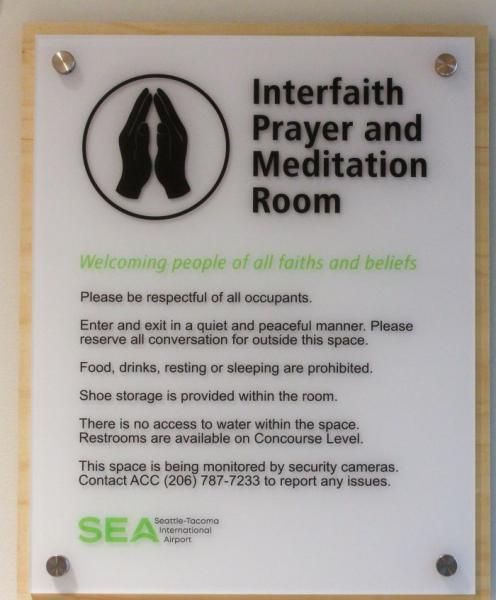
About the authors
Aneelah Afzali
is Executive Director of the American Muslim Empowerment Network at the Muslim Association of Puget Sound (MAPS-AMEN). She is also a Governing Board Member of the Faith Action Network and co-lead of the Faith Leaders Action Group. A graduate of Harvard Law School, Aneelah left her legal career in 2013 after a spiritual transformation to serve as an educator, community activist, and interfaith leader. Since then, she has worked locally and nationally to build bridges of understanding and unity and to advocate for justice. Aneelah was named one of the 2017 Most Influential People by Seattle Magazine, the 2018 American Muslim of the Year by CAIR National, and a 2018 Rising Brand Star by Adweek.
Steve Wilhelm
has been meditating since 1968 and engaged in Buddhist practice since 1987. He has studied and practiced in several Buddhist traditions, including extended retreats, although his practice is primarily early Buddhism. Steve has facilitated Eastside Insight Meditation in Kirkland since 2000, and is a “local Dharma leader” for Seattle Insight Meditation Society. He serves on the board of the Tibetan Nuns Project, a Seattle-based NGO supporting Tibetan refugee nuns in India. Before Steve retired in 2016, he worked for 35 years as a journalist, most of it covering aerospace, ports and international trade for Puget Sound Business Journal in Seattle. He has edited four Buddhist books. He lives in Kirkland with his wife Ellen.

